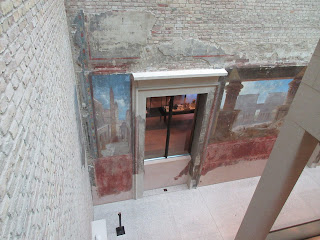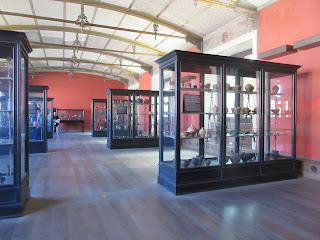Kesällä Lejren arkeologisessa ulkoilmamuseossa käydessä tuli törmättyä tekstiilitekniikkaan josta en ollut aikaisemmin kuullutkaan -kehrääminen kehruukoukun (ruots. spinnkrok) avulla. Tämähän alkoi sitten kiinnostaa valtavasti, olen kehrännyt pääasiassa -ja silloinkin melko satunnaisesti- värttinällä mutta tietysti kaikkea täytyy koittaa. Ja kohtuullisella menestyksellä koitettiinkin!
In the summer when I visited the Lejre archaeological open air museum I came across a textile technique I had never seen before -spinning with a spinning hook (spinnkrok in Swedish). It got me really curious, I've so far spun mostly with a spindle and my experience is limited with that, too. So I had to put the technique to test, and those tests ended up being quite successful!
In the summer when I visited the Lejre archaeological open air museum I came across a textile technique I had never seen before -spinning with a spinning hook (spinnkrok in Swedish). It got me really curious, I've so far spun mostly with a spindle and my experience is limited with that, too. So I had to put the technique to test, and those tests ended up being quite successful!
Opastusta löytyi mukavasti Youtubesta -tämä video on ruotsiksi mutta eipä tuossa juuri sanoja tarvita, esittely on melko yksiselitteinen vaikkei kieli taipuisikaan.
Youtube videos provided guidance. This video is in Swedish but not much words are needed, this is quite self-explanatory even if one wouldn't understand a word.
Tekniikan historia ja maininnat teoksissa ~~~~ History of the technique and written records
Tätä kehruutekniikkaa kutsutaan värttinän edeltäjäksi, mutta jostain syystä löysin tietoja tästä tekniikasta käytännössä ainoastaan Ruotsista mitä tulee langan kehruuseen, ja nämäkin vähät tiedot olivat huomattavan vanhoista teoksista (jos joku tietää enemmän, olen äärettömän kiinnostunut kuulemaan!). Oscar Montelius mainitsee tekniikan pronssikautiseksi, perustellen sillä että siltä ajalta ei hänen mukaansa ole tiedossa värttinänkehriä vaikka villalankaa onkin (kirj. v. 1877).¹ Toim. huom. Montelius tarkoittaa tässä nimenomaan Ruotsin ja Tanskan aluetta, etelämpää, Saksastakin jo, tunnetaan kuitenkin kehriä ihan kivikautta myöten (mm. esillä Berliinin Neues Museumissa)...
This technique is said to be a predecessor for a spindle, but for some reason I found information about it only from Sweden when it comes to spinning yarn -and that information is quite old, mostly late 19th century (should anyone know more, I'd be super grateful for any info!). Oscar Montelius notes that it might be a bronze age technique, since there are no spindle whorls from that period although woolen yarn is known (written in 1877).¹ Montelius meant here specifically Swedish and Danish finds, because in central Europe spindle whorl finds are well known even from the neolithic times, for example from Germany (exhibited in Neues Museum, Berlin)...
Muutamaa vuotta aiemmin (1871) N.M. Mandelgren oli esitellyt kehruukoukkua ja sen käyttöä ja mainitsi samalla tekniikan säilyneen käytössä eteläisessä Ruotsissa, ts. Skånessa, Hallannissa, Blekingessä ja Smålannissa. Myös Mandelgren esittää tekniikkaa vanhimmaksi kehruutekniikaksi ja esittelee samassa artikkelissaan myös muita vanhoja menetelmiä.²
Some years earlier (1871) N.M. Mandelgren wrote about old textile techniques and mentiones spinning hook as well. He notes that its use has been a living tradition in southern Sweden, ie. Skåne, Blekinge and Småland. Also Mandelgren states that it is the oldest method of spinning.²
Some years earlier (1871) N.M. Mandelgren wrote about old textile techniques and mentiones spinning hook as well. He notes that its use has been a living tradition in southern Sweden, ie. Skåne, Blekinge and Småland. Also Mandelgren states that it is the oldest method of spinning.²
Sekä Mandelgren että Montelius mainitsevat erilaiset kehruumateriaalit kehruukoukun yhteydessä, sekä villan, eläimenkarvat että pellavan. Muutamia vuosikymmeniä Mandelgrenin ja Monteliuksen jälkeen Ragnar Jirlow mainitsee kehruukoukun nimenomaan pellavankehruuvälineiden yhteydessä, mutta toteaa että kehruukoukun käytöstä ei ole paljoa tietoa.³
Both Mandelgren and Montelius mention various spinning materials when using spinning hook, wool, animal fur and linen. Some decades later Ragnar Jirlow presents spinning hook specifically as a linen processing tool. He also states that not much is known of the use of spinning hook.³
Kaikkein tuoreimmat maininnat kehruukoukusta löytyvät kalastusvälineosastolta 1930-luvulta -tokihan väline taipui myös verkon niinen kehräämiseen. Ruotsin Kringla-tietokannasta löytyneen koukun alkuperä sijoittuu sekin eteläiseen Ruotsiin.
The newest notes of spinning hook are found from the 1930s when it is shown as a part of fishing equipment -of course one can make bast yarn with it too, and bast then again was used in making fishing nets. The spinning hook found in the Swedish Kringla database is also southern Swedish in origin.
The newest notes of spinning hook are found from the 1930s when it is shown as a part of fishing equipment -of course one can make bast yarn with it too, and bast then again was used in making fishing nets. The spinning hook found in the Swedish Kringla database is also southern Swedish in origin.
| Lehmuksen niinen kehruussa käytetty koukku 1930-luvulta Ruotsista ~~~ Hook used in spinning bast from the 1930s Sweden |
Omat kokeilut ~~~~ My own experiments
Aloitin testaamisen kehräämällä vuosikausia tyhjän panttina kököttäneen ohuen hahtuvalangan langaksi, ihan periaatteella että haetaan tuntumaa välineeseen (ja pistetään hahtuva hyötykäytöön). Ja koska materiaali oli tasaisen hyvää, tuli langastakin kertaheitolla nättiä! Ensitunnelma oli, että verrattuna värttinään kehrääminen on hieman hitaampaa, mutta kontrolli langan kierteeseen on jossain määrin parempi. Koukku suorastaan itse ilmoitti sopivan täyttöasteensa, keristä tuli hyvin samankokoisia 12-16 gramman palleroita.
I started my test with spinning a skein of thin pre-yarn, thinking that this way I'll get some elementary idea of the technique (and put the pre-yarn to some use, it had just been sitting there for years). And because the starting material was even and good quality, thread became very nice too right from the start. My first impression was that when compared to spindle, spinning with a hook is slower but a spinner has somewhat more control to the twist of the thread. It was as if the hook itself stated how much thread is enough. The skeins ended up very similar in size, 12-16 grams of thread in one ball.
 |
| Kaikkineen 85 grammaa valmista! ~~~ 85 grams of thread altogether! |
Toinen kokeilu oli valmiiksi karstatusta öölantilaisesta Äpplerumin tilan villasta. Hienoa ja valmiiksi hyvin käsiteltyä sekin, joten sen kehrääminen ei ollut oleellisesti vaikeampaa kuin valmiin hahtuvalangan. Testaukset jatkuvat, seuraavaksi täytyy varmaan koittaa itse käsitellyllä villalla ja testailla primitiivisiä metodeja siinäkin, jousi kiinnostelisi kovasti...
The second experiment consisted of readily-carded wool fluff from Öland, Äpplerum farm. Fine wool and well-processed, so spinning it was not really more difficult than spinning the pre-yarn. Next I think I'll try some hand-processed wool and test some primitive methods, bow or willowing perhaps!
¹ Montelius, Oscar: Sveriges hednatid, samt medeltid, förra skedet frår år 1060 till år 1350 , p. 23-24 (1877)
² Mandelgren, N.M: Om äldre spinnredskaper och spinnsätt. Svenska fornminnesförenings tidskrift, n:o 2, 1871
³ Jirlow, Ragnar: Om linberedning och linspinning hos svensk allmoge. Fataburen: kulturhistorisk tidskrift, 1924.





























